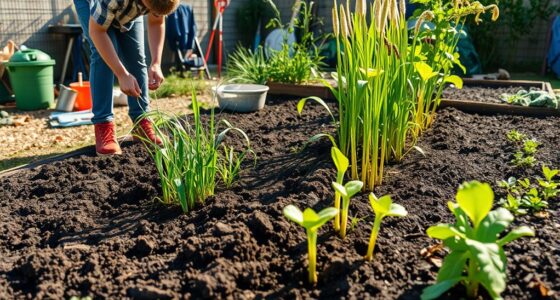To care for your Monstera, place it in bright, indirect light to promote healthy growth while avoiding sun scorch. Water when the top inch of soil feels dry, ensuring good drainage to prevent root rot. Support tall or vining varieties with stakes, moss poles, or trellises, and secure stems gently. Keep an eye on signs of stress like yellowing or browning leaves, and adjust your care routine accordingly. Want to master every detail? Keep exploring for expert tips.
Key Takeaways
- Provide bright, indirect sunlight and rotate the plant seasonally for even growth and vibrant foliage.
- Water when the top inch of soil is dry, ensuring proper drainage to prevent root rot.
- Use sturdy supports like moss poles or stakes, securing stems with breathable ties for upright growth.
- Regularly prune dead or yellowing leaves to promote healthy development and airflow.
- Adjust watering, light, and humidity seasonally, reducing watering in winter and increasing light and humidity in summer.
Understanding Your Monstera’s Lighting Needs
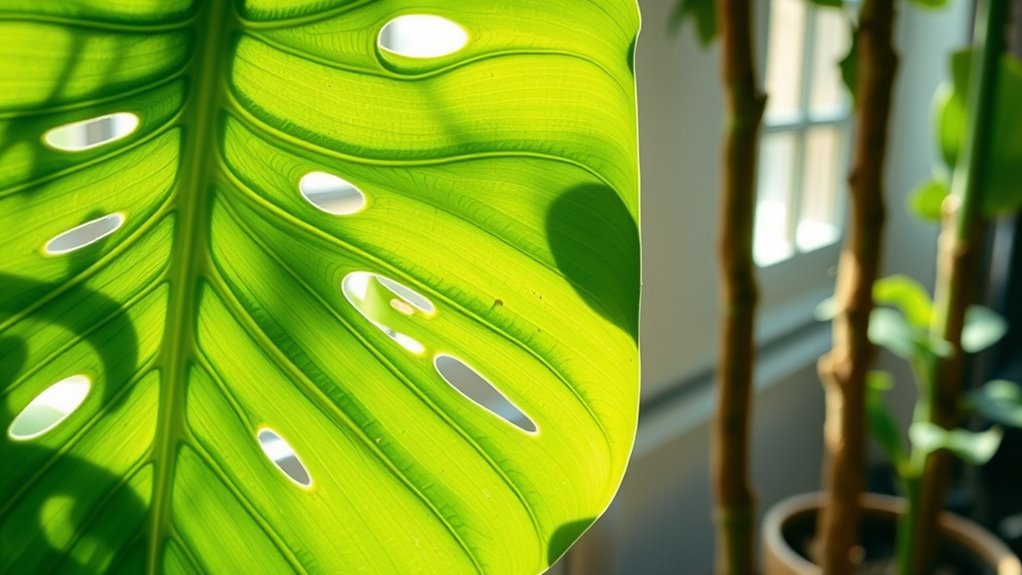
To keep your Monstera healthy and thriving, it’s essential to understand its lighting needs. Proper light encourages strong growth and vibrant leaves. Place your Monstera in bright, indirect sunlight; direct sun can scorch its leaves, while too little light hampers growth. When considering soil composition, use well-draining soil to prevent water from sitting around the roots, which can cause root rot and attract pests. Good soil also helps maintain consistent moisture levels, supporting healthy foliage. Additionally, the intensity of light affects the plant’s overall health and appearance, making light management crucial for optimal growth. Adequate lighting minimizes pest problems by reducing stress on your plant, making it less susceptible to common issues like spider mites or scale. Regularly inspect your Monstera for pests and adjust lighting conditions as needed to keep it thriving and pest-free. Understanding soil composition and its impact on water retention can further improve your plant’s health, as well as considering natural materials like wood and linen used in farmhouse decor can inspire creative container choices that complement your plant’s aesthetic.
How to Water Your Monstera for Optimal Health
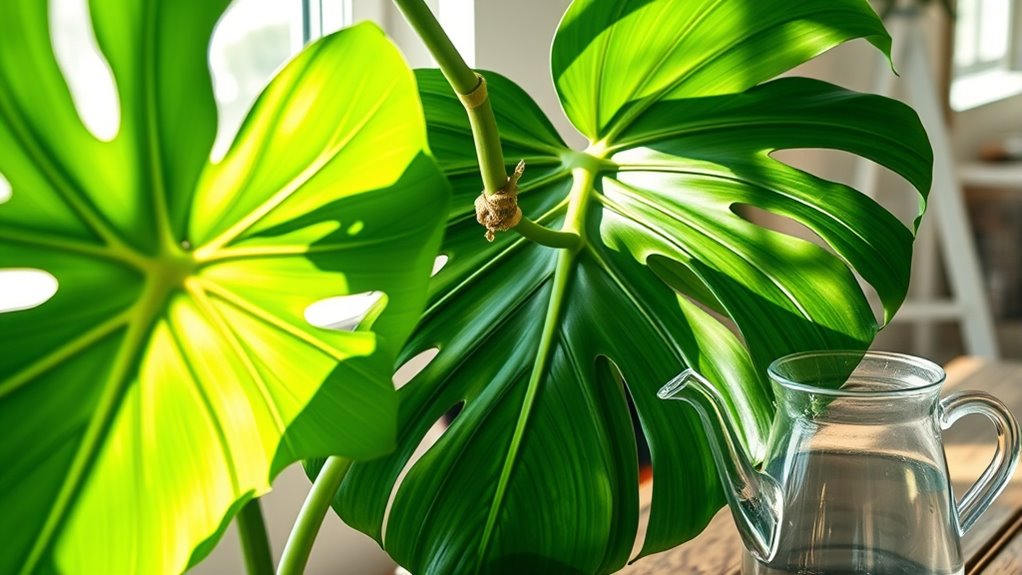
Proper watering is essential for your Monstera’s health, as overwatering can lead to root rot while underwatering causes stress and leaf damage. Water your Monstera when the top inch of soil feels dry. Guarantee excess water drains well to prevent soggy roots. A consistent watering schedule helps maintain balance, reducing pest risks and supporting healthy growth. Use the table below to guide your watering routine and fertilizer schedule:
| Watering Frequency | Fertilizer Schedule | Pest Prevention Tips |
|---|---|---|
| Every 1-2 weeks | Monthly during growing season | Check leaves regularly for pests |
| Adjust in winter | Use balanced fertilizer | Keep foliage dry to avoid pests |
| Ensure drainage | Follow label instructions | Quarantine new plants |
Stick to this routine to keep your Monstera thriving. Regularly monitoring soil moisture levels and understanding plant care basics can further improve your plant’s health. Additionally, using the appropriate headphone connectors can enhance your listening experience when enjoying music or podcasts. Proper lighting and humidity levels also play a crucial role in Monstera plant health, ensuring your plant remains vigorous and vibrant.
Providing Support: Staking and Training Your Monstera

Supporting your Monstera as it grows is essential to keep it healthy and looking its best. Proper staking and training help prevent damage and promote a lush, balanced shape. When staking, use sturdy supports and gentle ties to guide your plant’s vines upward. Regular repotting techniques ensure the roots have space to expand, reducing the risk of pest infestation by preventing overcrowding. Training your Monstera also involves pruning dead or yellowing leaves, which can attract pests. Here are three key tips:
Supporting your Monstera with sturdy supports, gentle ties, and regular repotting promotes health and lush growth.
- Use breathable materials like moss or fabric ties to secure stems without harming them.
- Regularly inspect for pests and clean supports to prevent pest buildup.
- Repot when roots outgrow the current container, following proper repotting techniques for minimal stress.
- Incorporating supportive structures can enhance stability and encourage healthy growth.
- Ensuring optimal light conditions helps your Monstera thrive and develop a vibrant, healthy appearance.
- Staying aware of AI safety measures and monitoring for vulnerabilities can help protect your plant support setup from potential issues.
Recognizing Signs of Light and Water Stress
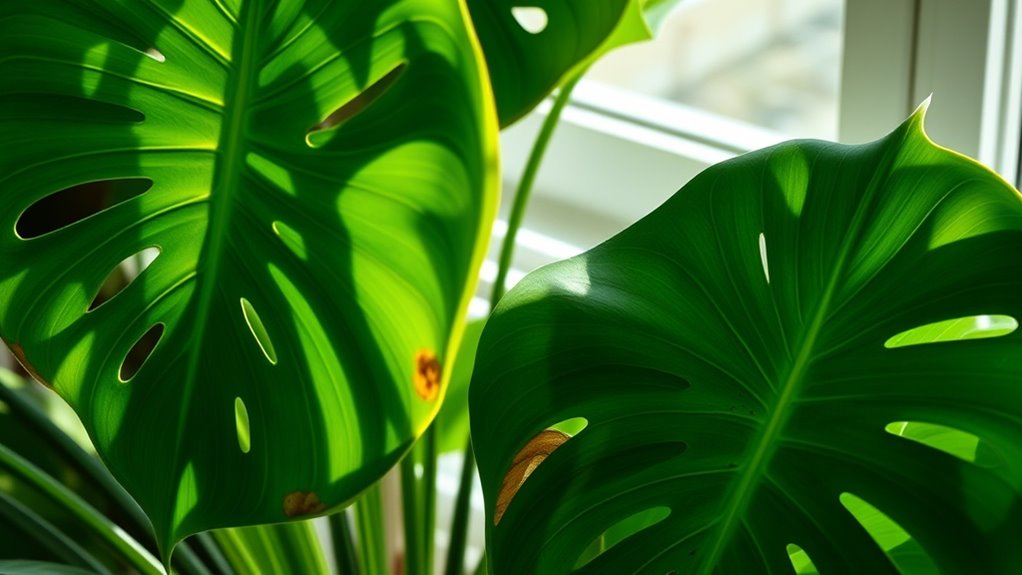
Monitoring your Monstera closely helps you catch early signs of light and water stress before they cause long-term damage. Watch for leaf discoloration, such as yellowing or browning, which signals inconsistent watering or too much direct sunlight. Overwatering can lead to root rot, causing leaves to wilt or develop dark, mushy patches. Conversely, too little water results in drooping, dry leaves, and stunted growth. Check your plant regularly to spot these signs early. Use this quick reference:
| Sign of Stress | What It Indicates |
|---|---|
| Leaf discoloration | Excess light or inconsistent watering |
| Wilting or drooping | Overwatering leading to root rot or underwatering |
| Browning edges | Too much direct sunlight or dry conditions |
| Mushy roots | Root rot from overwatering, risking leaf health and stability |
Additionally, understanding the importance of proper lighting can greatly influence your plant’s health. Ensuring your Monstera receives appropriate bulb maintenance can also help maintain optimal growth conditions.
Adjusting Care for Different Monstera Varieties
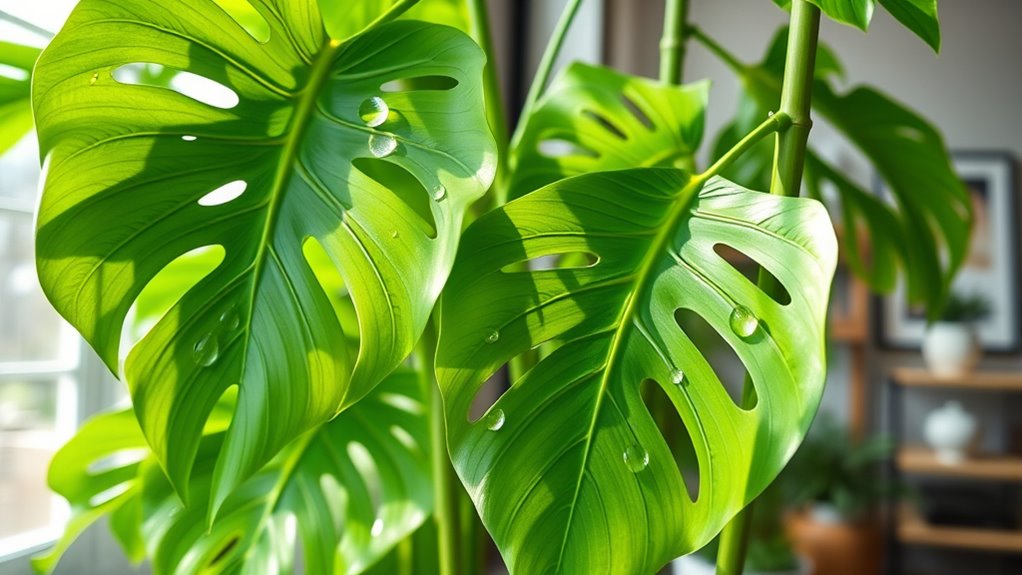
Different Monstera varieties have unique light, watering, and support needs. Some thrive in bright indirect light, while others prefer lower light levels. Adjusting your care routine accordingly guarantees each variety stays healthy and vibrant. For optimal growth, providing the appropriate light conditions tailored to each variety is essential. Understanding the specific growth habits of each Monstera type can help you better meet their individual needs. Additionally, recognizing the support requirements for larger or more vigorous varieties ensures they grow upright and healthy.
Varietal Light Needs
While all Monstera varieties thrive in bright, indirect light, their specific light needs can vary considerably. To optimize growth and health, consider these factors:
- Varietal light needs: Some varieties, like Monstera deliciosa, tolerate lower light levels, while others, such as Monstera adansonii, prefer brighter conditions. Adjust your placement accordingly.
- Soil drainage: Good soil drainage helps prevent root rot, especially in varieties that prefer slightly sunnier spots. Ensure the soil allows excess water to escape.
- Light intensity: Monitor leaf color and size; pale or stretched leaves indicate insufficient light, prompting you to move your plant closer to a light source without direct sun.
Understanding these variations helps you provide tailored care for each Monstera variety.
Watering Variations
Watering needs can vary considerably among Monstera varieties, and adjusting your routine accordingly guarantees healthy growth. Some Monsteras prefer more frequent watering, while others thrive with less. Pay close attention to soil moisture; most Monsteras like the top inch of soil to dry out before watering again. For faster-draining soils, you might need to water more often, whereas heavier soils retain moisture longer. If your Monstera’s leaves start yellowing or the soil stays wet for too long, cut back on watering. Conversely, if the leaves become crispy or wilted, it’s time to increase watering frequency. Regularly checking soil moisture helps you tailor your watering routine to your specific Monstera variety’s needs, promoting healthy, vibrant growth. Additionally, understanding your plant’s watering variations can help prevent overwatering or underwatering issues. Monitoring these watering needs ensures your Monstera remains healthy and vigorous, and considering proper drainage can further improve overall care.
Support Requirements
Support requirements for Monstera plants can vary considerably depending on the variety and growth stage. Some varieties are naturally more vigorous and need extra support structures to prevent damage or toppling. You should choose trellis options that suit your plant’s size and climbing habits. A variety of support options, such as moss poles, bamboo stakes, or trellises, can be used to accommodate different growth patterns. Consider these support strategies: 1. Use sturdy support structures like moss poles or bamboo stakes that help the plant grow upright. 2. Adjust trellis options based on the size of your Monstera, providing enough room for its aerial roots. 3. Regularly secure the stems to support structures with plant ties to encourage healthy, vertical growth. Additionally, understanding the home decor can help you create an attractive and functional space for your plants, just as varied brewing methods influence coffee flavor profiles. Incorporating proper support is essential for maintaining the health and aesthetic appeal of your Monstera as it matures.
Seasonal Care Tips to Keep Your Monstera Thriving

As the seasons change, adjusting your Monstera’s care guarantees it stays healthy and vibrant year-round. During colder months, reduce watering frequency to prevent overwatering and root rot. Use proper pruning techniques to remove dead or yellowing leaves, which encourages healthy growth and improves airflow. This also helps prevent pests that thrive in decaying plant matter. Keep an eye out for pests like spider mites or scale, especially in dry seasons, and address infestations promptly to maintain plant health. In warmer months, increase humidity and light exposure to support vigorous growth. Regularly inspecting your Monstera and adjusting care routines ensures it stays strong and thriving, regardless of the season. Proper seasonal adjustments make all the difference in your Monstera’s overall health.
Common Mistakes to Avoid in Monstera Maintenance
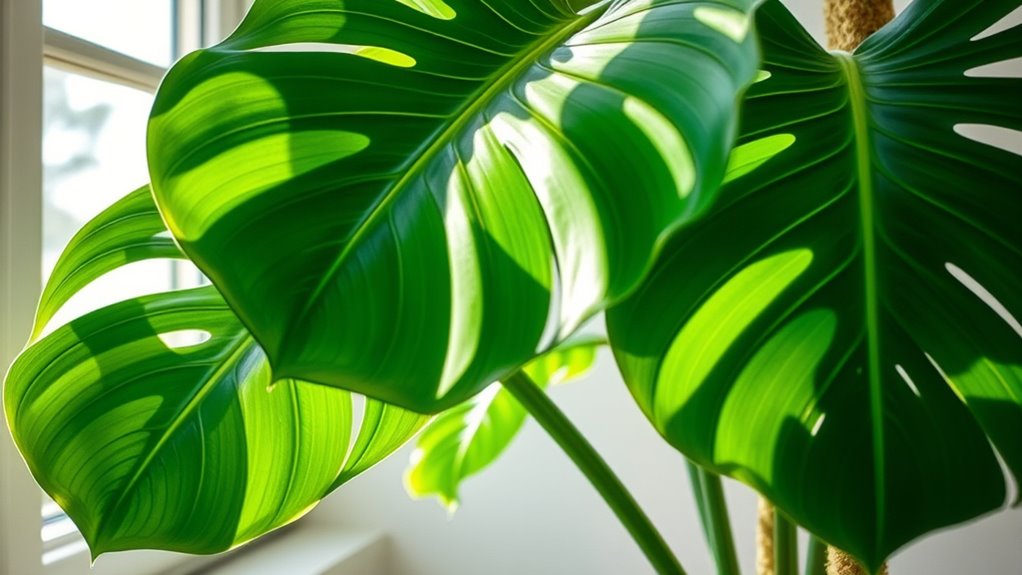
One of the most common mistakes in Monstera maintenance is overwatering, which can lead to root rot and other health issues. Too much water encourages foliage overgrowth, making your plant look unruly and increasing pest risks. To avoid these problems, steer clear of these mistakes:
- Ignoring proper drainage—ensure your pot has drainage holes to prevent water from sitting.
- Overwatering frequently—wait until the top inch of soil dries out before watering again.
- Neglecting pruning—regularly trim excess foliage to control overgrowth and improve airflow, reducing pest problems.
Frequently Asked Questions
How Often Should I Fertilize My Monstera?
You should fertilize your monstera every four to six weeks during the growing season to maintain healthy soil nutrients. Use a balanced, water-soluble fertilizer diluted to half strength to avoid overfeeding. In winter, reduce fertilization or pause it altogether, as growth slows down. Stick to a consistent fertilization schedule to support vibrant leaves and strong roots, ensuring your monstera thrives indoors or outdoors.
What Temperature Ranges Are Ideal for Monstera Growth?
You should aim for a temperature range between 65-85°F (18-29°C) for ideal monstera growth. Temperature regulation is key, especially during seasonal variations, to prevent stress or damage. Keep your monstera away from cold drafts or direct heat sources. Consistent warmth encourages healthy growth, so monitor indoor conditions closely, adjusting as needed. This helps your plant thrive and develop those iconic leaves beautifully.
Can Monstera Thrive Outdoors Year-Round?
You might wonder if your monstera can thrive outdoors year-round. While it loves warm, humid environments, outdoor watering needs change with seasonal shifts. In summer, it benefits from regular watering, but in winter, you should reduce watering as temperatures drop. Keep an eye on weather patterns, and bring your monstera indoors during cold or frosty periods to prevent damage from seasonal changes.
How Do I Propagate My Monstera Plant?
Oh, propagation techniques are just so straightforward, right? You simply cut a healthy stem with at least one node, then place it in water or soil. Keep the soil moist or change the water regularly. Watch for root development—usually a few weeks—and once roots are established, you can transplant your monstera. It’s a rewarding process that turns a simple cutting into a thriving new plant.
What Pests Commonly Affect Monstera Plants?
You should regularly check your monstera for pests like spider mites, mealybugs, and scale, as they’re common problems. Pest prevention involves keeping leaves clean and avoiding overwatering, which can attract pests. If you notice any signs, quickly identify the pests to treat effectively. Regular pest identification helps you catch infestations early, making it easier to control and protect your monstera’s health.
Conclusion
With the right light, water, and support, your monstera can thrive. For example, Sarah noticed her plant’s leaves yellowing due to improper watering, but after adjusting her routine, it regained its lush appearance. Keep an eye on signs of stress and adapt your care accordingly. When you stay attentive and consistent, your monstera will grow healthier and more vibrant, turning your space into a lush, tropical oasis you’ll love to watch flourish.




